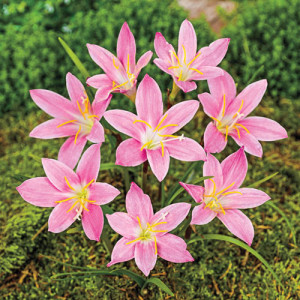
ZEPHYRANTHUS CARINATA
There are days when I want to live in the moment, celebrate the quotidian experience and relish immediate delights—like the many stands of snowdrops currently on display in various parts of my garden. Other days, I am drawn to the past; especially when I think about people and places that exist only in memory. Being a gardener, though, also means living in the future and planning for seasons to come. Right now we plant seeds that will sprout in ten days and bloom in eight weeks, not to mention ordering perennials that will flower in mid-summer. In a few weeks, we will buy starter tomato and pepper plants, knowing that we will not taste the fruits for a couple of months. In early fall we plant daffodils and tulips in the hopes that we and they will survive winter and rise in glory when spring rolls around.
Many people plant bulbs in the fall, but some of us also do so in spring. I was trolling the nursery aisles the other day when plant lust forced me to buy a package of Zephyranthes bulbs, which I intend to pot up in the next week or so. I was looking for a particular brand of mint-scented deer spray, but came home with bulbs. There is no excuse for this other than the fact that distractions are plentiful in garden centers and the need for brightness is particularly strong this year.
“Zephyranthes” comes from the Latin words for “west wind” and “flower”. This is a poetic description of the plant’s western hemisphere origins and its attention-getting blooms. The common name, which is easier to read and pronounce, is “rain lily”. “Fairy lily” is another name that gets play in some places. The plants are small and somewhat crocus-like, usually rising from four inches to twelve inches, depending on the species. The foliage is somewhat grassy and appears at the base of each plant. As card-carrying members of the amaryllis or Amaryllidaceae family, rain lilies proudly sport trumpet-shaped flowers at the tops of each bloom stalk. Those flowers, which will remind you of their much larger amaryllis or hippeastrum cousins, may be white, pink, yellow, or, more rarely, red. Patience is key with Zephyranthes, because even if you pot them up soon, they may not blossom until late July, early August or even later, again, dependent on species.
The name rain lily is slightly deceptive, because these lovelies don’t bloom when it is raining, but right after. This makes them like the flowering plants native to desert areas that do nothing until after a heavy downpour and then burst into carpets of color as the skies clear.
The package of bulbs I bought at the garden center is labeled “Zephyranthes” without reference to species. The flashy picture on the bag shows a mix of pink, yellow and white, so I suspect that I have a combination of Zephyranthes candida, Zephyranthes citrina, and Zephyranthes grandiflora, in white, yellow and pink respectively. The different species may bloom at slightly different times, allowing me to boast to friends about the trouble I took to ensure succession of bloom.
In my opinion, gardeners should brag about the following: positive actions taken deliberately; good things that happen despite neglect and/or laziness; and serendipitous events that don’t fit in either of the other categories. It is good for morale.
Like all of us, rain lilies have certain needs. The plants are tender in cold winter areas, though Zephyranthes candida is supposedly hardy in USDA plant hardiness zone 7a, where average annual extreme winter low temperatures go no lower than five degrees Fahrenheit. I live in that zone and grow my rain lilies in pots. If I were to put the white rain lilies in the ground, I would do it in a protected spot with a heavy layer of mulch on top.
Whether you grow rain lilies in the garden or in pots, plant them about two inches deep. In the garden, plant them two inches from their neighbors; in pots they can be placed closer together. Sunshine is key. Water during dry spells.
The diminutive size of rain lilies makes them useful in rock gardens, small beds or the fronts of larger beds. Interplant the bulbs with annuals so that you will have something in bloom while the rain lilies languish in late spring and early summer.
If you are like me, you will plant rain lilies and stop thinking about them shortly thereafter, except to remind yourself of the reason why you keep a soil-filled container that appears devoid of plants on the porch or patio. One day, late in summer, it will rain and the flowers will burst forth. They will be worth the wait.
Preserve your zephyranthes bulbs by lifting them in late fall, letting them dry a bit, and storing them in a cool dry place until you are ready to plant them again the following spring.
Zephyranthes were first discovered by Spanish explorers in the 1500’s. If you would like to discover them this season, you can probably find packages of bulbs at big box stores or large garden centers. If you hurry, you can also order them from Old House Gardens, 4175 Whitmore Lake Road, Ann Arbor, MI 48105; (734) 995-1486; www.oldhousegardens.com. Print catalog available.
